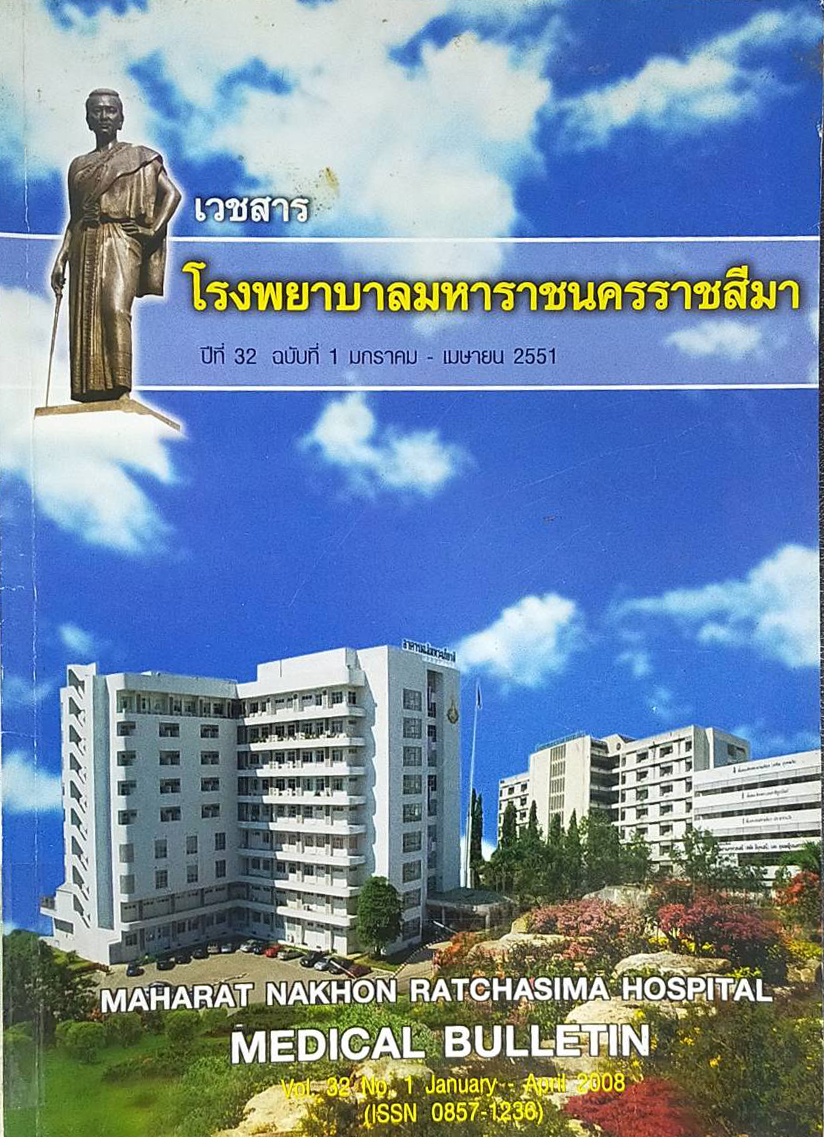ปัจจัยที่เกี่ยวข้องกับการเกิดทุพพลภาพระยะยาวในผู้สูงอายุ เขตพื้นที่ศูนย์สุขภาพชุมชนแห่งหนึ่ง จังหวัดนครราชสีมา
Main Article Content
บทคัดย่อ
วัตถุประสงค์: สำรวจอัตราความชุกภาวะทุพพลภาพระยะยาวและสภาวะโรคเรื้อรัง ระบุปัจจัยที่เกี่ยวข้องกับ ภาวะทุพพลภาพและจัดลำดับความสำคัญของปัญหา วิธีการศึกษา: การศึกษาเชิงสำรวจ ทุพพลภาพระยะยาวคือการขาดหรือมีข้อจำกัดของความสามารถในการดำรงชีวิตจากความเจ็บป่วยมากกว่า 6 เดือน กลุ่มตัวอย่างเป็นผู้สูงอายุ > 60 ปี ถูกคัดเลือกโดยวิธี two-stage, stratified, random cluster sampling และใช้แบบสัมภาษณ์มาตรฐาน คำนวณ Odds ratio (OR) และ 95% confidence interval (95%CI) และสัดส่วนอัตราเสี่ยงกระทบ ผลการศึกษา: อัตราความชุก ทุพพลภาพระยะยาวเท่ากับร้อยละ 25.6 (81/316) สภาวะความเจ็บป่วยที่พบบ่อยและเกี่ยวข้องกับทุพพลภาพระยะยาว คือ ปวดเข่า/ข้ออักเสบ (ร้อยละ34.4) ปวดหลัง (ร้อยละ 23.3) และ ต้อกระจก/ตามัว (ร้อยละ 19.3) ปวดเข่า/ข้ออักเสบ สัมพันธ์กับการเกิดทุพพลภาพระยะยาวมากที่สุด (OR 2.68, 95% CI 1.51, 4.74) รองลงมาคือ ต้อกระจก/ตามัว (OR 2.25, 95%CI 1.19, 4.24) และปวดหลัง (OR 2.19, 95%CI 1.15, 4.16) สัดส่วนอัตราเสี่ยงกระทบในกลุ่มปวดเข่า/ข้ออักเสบ เท่ากับ ร้อยละ 36.6 รองลงมาคือปวดหลัง ร้อยละ 21.7 และ ต้อกระจก/ตามัว ร้อยละ 19.4 สรุป: ปัจจัยที่สัมพันธ์กับภาวะทุพพลภาพระยะยาวในผู้สูงอายุคือ ปวดเข่า/ข้ออักเสบ สอดคล้องกับผลการวิจัยในต่างประเทศ ควรใช้ข้อมูลนี้เป็นแนวทางในการวางแผนป้องกันทุพพลภาพในเขตพื้นที่ศูนย์สุขภาพชุมชน
Article Details

อนุญาตภายใต้เงื่อนไข Creative Commons Attribution-NonCommercial-NoDerivatives 4.0 International License.
เอกสารอ้างอิง
Graciani A, Banegas JR, Lopez-Garcia E, Rodriguez-Artalejo F. Prevalence of disability and associated social and health-related factors among the elderly in Spain: a population-based study. Maturitas 2004; 48: 381-92.
Fried LP, Guralnik JM. Disability in older adults: evidence regarding significance, etiology and risk. J Am Geriatr Soc 1997; 42: 92-100.
Raina P, Dukeshire S, Lindsay J, Chambers LW. Chronic conditions and disabilities among seniors: an analysis of population-based health and activity limitation surveys. Ann Epidemiol 1998; 8: 402-9.
Mor V, Wilcox V, Rakowski W, Hiris J. Functional transitions among the elderly: Patterns,predictors, and related hospital use. Am J Public Health 1994; 84: 1274-80.
Badly EM, Rasooly I, Webster GK. Relative importance of musculoskeletal disorders as a cause of chronic health problems, disability, and health care utilization: Findings from the 1990 Ontario Health Survey. J Rheumatol 1994; 21: 505-14.
Verbrugge LM, Patrick DL. Seven chronic conditions: Their impact on US adults’ activity levels and use of medical services. Am J Public Health 1995; 85: 173-82.
Jitapunkul S, Kunanusont C, Phoolcharoen W, Suriyawongpaisal P, Ebrahim S. Disability-free life expectancy of elderly people in a population undergoing demographic and epidemiologic transition. Age Ageing 2003; 32: 401-5.
Greenland S. Bias in methods for deriving standardized morbidity ratio and attributable fraction estimates. Stat Med 1984; 3: 131-41.
von Strauss E, Aguero-Torres H, Kareholt I, Winblad B, Fratiglioni L. Women are more disabled in basic activities of daily living than men only in very advanced ages: a study on disability, morbidity, and mortality from the Kungsholmen Project. J Clin Epidemiol 2003; 56: 669-77.
Kattainen A, Koskinen S, Reunanen A, Martelin T, Knekt P, Aromaa A. Impact of cardiovascular diseases on activity limitations and need for help among older persons. J Clin Epidemiol 2004; 57: 82-8.
Dunlop DD, Semanik P, Song J, Manheim LM, Shih V, Chang RW. Risk factors for functional decline in older adults with arthritis. Arthritis Rheum 2005; 52: 1274-82.
Wannamethee SG, Shaper AG, Whincup PH, Walker M. Overweight and obesity and the burden of disease and disability in elderly men. Int Obes 2004: 1-9.


